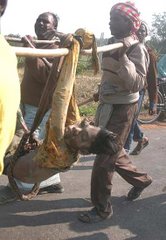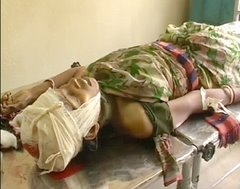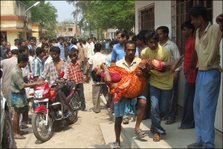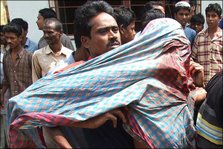Nandigram and the Unravelling of Social Democracy - Blog article (open for comments)
June 12, 2007
By Saroj Giri, Sanhati
Movements against displacement have for a long time been understood in India largely in pre-political terms of an almost natural opposition between an undifferentiated modernity of global capitalism and equally undifferentiated local communities of traditional societies. Kalinganagar and Nandigram, in putting up a tenacious resistance to capital and the state, have however made such viewpoints untenable and call for a political understanding of movements against displacement. Events in Nandigram therefore will be here presented in the light of the decomposition of social democracy represented by the CPIM. The jolt of Nandigram comes at a time when, after long years of social democratic containment of working class movements, the party was just settling down to actively spearhead the march of capital in the state.
Nandigram, like Narmada or Kalinganagar, marks a specific conjuncture in the balance of political forces, of class and power relations and hence cannot be understood as yet another ‘movement against displacement’ whose contours are given from before. Nandigram represents an implosion against the specific conjunction between social democracy and neo-liberalism. It has dealt an early blow to the CPIM’s vanguardist role as enforcer of capital’s interests in the state. Further, in both their methods of resistance as also their success in forcing capital to retreat, Kalinganagar and Nandigram stand out as marking a break from neo-Gandhian social movements like the Narmada Bachao Andolan.
Indian democracy
In Indian democracy till recently, while the parties like the Congress and the BJP were directly in the interests of capital, those like the CPIM and the Socialists, that is the social democratic left, played the role of controlling and limiting working class struggles against capital [1]. It was as though the Congress and the BJP actually planted and run the capitalist machine; the CPIM and others protected it from assaults by the working class. But in the division of powers and shares, the latter were always of secondary importance: after all, they only guarded the machine, the system from outside, never themselves taking the burden of owning, running, managing it.
Around the early 1990s however as the international and national balance of forces between capital and labour went in capital’s favour, and capital emerged stronger and more confident, capital’s need for social democratic protection became negligible. From the viewpoint of the system as a whole, social democracy lost its rationale. It has to now find ways to save itself or be ready to accept the end of its own history. While it might have lost its systemic use to capital, the CPIM however holds political power in West Bengal. So it need not go into oblivion. It will use what it has at its disposal to prove itself useful to capital. It crosses over to the other side.
In a situation where capital does not need social democracy to rein in the working class, where capital is strong and labour weak, but where as in West Bengal today social democracy still holds political power, capital can march without much problems since social democracy’s political power and clout can work to neutralise any working class opposition to capital. However given that capital perceives hardly any threat from working class movements, when the social democratic party in order to save itself from oblivion, deserts the working class and jumps completely to the side of capital, things can go in either of two directions. It might lead to complete domination and hegemony of capital so that class contradictions go extinct – a post-Marxist assumption. Or, with what the working class thought to be its own party now leading the drive of capital, with no disguises among the working class, class polarisation sharpens and the resistance to capital gets radicalised. Kalinganagar, Singur and Nandigram point to this latter possibility.
Movements against displacement
Industrialisation projects have not, however, always faced the kind of sustained opposition not to speak of antagonism that we saw earlier in Kalinganagar and now in Nandigram. This cannot be explained only in terms of a general opposition of an undifferentiated ‘people’ or community to any attempt to displace them from their age-old habitat, and their refusal to loose their autonomy, self-sufficiency and freedom at the altars of again an undifferentiated modernity. Most accounts, particularly among proponents of local communities and indigenous ways of life as a bulwark against neo-liberalism, treat opposition to industrialisation and displacement in frustratingly pre-political terms, as though it is not itself a function of the particular balance of political forces, class and power relations that exist.
Even as presenting this opposition to displacement as primordial, spontaneous or natural (hence pre-political) might paint it as uncompromising or radical, with neatly given dichotomies of human/nature, science/tradition, community/state etc, it often works as no more than an ideological cover to the actual conflict of interests and class positions that constitute the movement. Among other things, treating movements against displacement in pre-political terms and hence as homogenous does not enable us to explain the differences between them, or the reasons for their failures and successes. More importantly, it does not give us politically relevant answers to why for example the Narmada Bachao Andolan failed. Frustration with such a way of thinking is what seems to be expressed by Arundhati Roy when she states: “The NBA had a lot going for it — high-profile leadership, media coverage, more resources than any other mass movement. What went wrong? People are bound to want to rethink strategy” [2].
If we are then not to portray Nandigram as another spontaneous, natural, primordial opposition by local communities to industrialisation then we need to examine the balance of political forces and the related class and power relations that constitute the socio-political terrain there. This is a task which cannot be done in a neutral, objective manner but in the spirit of partisanship against capital and the state. Nor is it an appeal for an objective social science understanding but as something which cannot be detached from the movement and its interests. In spite of the huge amount written on movements against displacement, hardly anything serious has been written on it from a political perspective, examining the class basis of the movement and its relationship to the various detachments of capital. I here provide an initial broad outline of one possible aspect of such a political understanding which can be described in terms of the decomposition of social democracy in India, with the CPIM a key component of this trend in the country.
Everytime in India, large numbers of people, as in Kalinganagar, Singur and Nandigram today, stood in a direct and antagonistic relation to capital and the state, a middle class ideology of alternative plans and people’s plans has not just acted to limit the initiative and political character of the movement to the ‘enlightened interests’ of the urban radical intelligentsia but, as a consequence, capital has instead ultimately gone ahead with its own original plans without even any kind of (green) restructuring. Kalinganagar earlier and now Nandigram however mark a new turning point, in this long tiring history of co-option and failures of movements against displacements.
Nandigram so far has stood up in its militancy and antagonism towards capital and the state without giving way to negotiations and appeals, dharnas and hunger strikes, and knocking at the doors of the powers that be. Reports from Nandigram seem to suggest that people are not just fighting to keep their land and their present means of livelihood but they are also destroying the relations of power that tied them to capital and the state: the CPIM after all is not exaggerating when it says Nandigram was beyond the reach of the law. The agitators blew off bridges, and cut off contact with state authorities or any representative of capital and the state [3]. While one has to examine the role played by dubious factions of capital and the state like the Trinamool Congress, Nandigram stands out for its refusal to engage in any dialogue or compromise with state authorities, for its refusal to bargain for its interests, better rehabilitation package etc with the state and agents of capital. Now the problem for the state is not just the setting up of the industrial plant there but of first bringing Nandigram back into channels of mediation and communication. As we shall see, the balance of political forces in terms of the specific trajectory of social democracy in the state is what explains the character of the movement against displacement in Nandigram.
Balance of political forces
Like all social democratic streams the CPIM’s long political history of course suited its present bid to don the interests of capital and usher in development of the state. Having successfully ‘run’ the working class movement for decades, with sound, time-tested knowledge of the ‘toiling masses’, the CPIM was, among the political forces, in fact best placed to push through the agenda of primitive accumulation of capital in the most unapologetic form of SEZs. Its misplaced confidence in pushing through this agenda in Nandigram and Singur was based on years of experience in containing working class movements at the service of capital.
However now that it closed all distance with capital and fully identified itself with it, there was no ‘neutral’ force or party left to do what the CPIM earlier did: negotiating between capital and labour in order to contain labour. This was partly the result of its dictatorial clout over political power in the state so that the state lacks any developed social movement, NGOs or citizen groups with some following in society that could have now carried out the CPIM’s earlier function of mediation and class compromise in favour of capital. Maybe it thought now that it is spearheading capital, how can the oppressed raise a voice against it. Maybe it hallucinated that it is now a party which cuts across classes, that it simultaneously represents the interests of both the capitalists and the oppressed masses: a classless party in a class-ridden society. Here, it fell victim to its own promise of bringing about the development of the state as a whole, as though this development represented the interests of all classes in the state.
By putting up an immediate and antagonistic opposition to capital and the state, Nandigram drove home the point that the CPIM and the development it promises are not just not above class interests but they are directly in the interests of capital. Further in refusing to be a party in the dialogues and discussions with the state Nandigram has steered clear of the alluring fictions of finding a middle path, of protecting the interests of all, in the interests, for example, of the development of the state as a whole. Forget the CPIM and the social democratic left. There is here a strange paradox for capital itself. As soon as capital in its confidence forsakes those who looked after its interests and guarded it from working class assaults, precisely in this moment of self-congratulatory celebration of its inevitable and uninterrupted march, the dispossessed and the oppressed offers the strongest and unyielding resistance. Maybe it was a bit too premature for capital to invite those guarding the outer frontiers to come and join in managing the system from the inside.
Thus, the situation in Nandigram going out of hand was not just a result of the CPIM’s dictatorial use of state power or of its utter disrespect of human rights. For it was true that the people in Nandigram had indeed refused any kind of negotiation or rehabilitation package: it was a radical situation and with no social movement representative or party or citizen’s group to negotiate and mediate on behalf of capital or of the people, the ground was indeed laid for a violent confrontation. Even as it spearheaded the onslaught of capital, the CPIM’s political dictatorship presented itself as the sole voice of the workers and peasants and the marginalised who are subjected to this onslaught. This meant that other social movements, NGOs etc could not work among the affected people as the negotiators/mediators to silence/infiltrate the movement in Nandigram. Nandigram, unrepresented and unmediated, stood on its own, without giving in to the machinations and sops of the representatives of any sector of capital and the state.
Such a situation led to a radicalisation of the movement, quite clear from the presence of Maoists in the movement. This is what explains the fighting spirit and radical position of the people in Nandigram and their unwillingness to buckle under pressure from the CPIM and the administration. This is what explains the fact that the people in Nandigram did not stand in awe at the upcoming industrial plant and desiringly watch the impressive equipments and machinery of capitalist industrialisation, ready to be part of it any moment. Nor is their self-understanding based on any kind of blanket rejection of modernity or of pitting the local versus the global [4].
With no middle class radicals able to put up base there, agitators in Nandigram, unlike in many other anti-displacement movements, have not fallen victim to the pre-political, class-effacing conceptualisations in terms of a blanket opposition to modernity. Thus the present movement can be understood only as an antagonistic opposition to the state and capital without taking an anti-modern stand to science and industry. It comes as a challenge to the post-modern, neo-Gandhian left represented by social movements and many NGOs. Foreshadowed by the unprecedented 431-day road blockade in Kalinganagar, in its tactics as well Nandigram has gone in for active resistance and antagonism in place of disobedience and satyagraha. The covert and not so covert presence of Maoists in the movement further proves this point.
Moribund social democracy, weakened working class movement and an aggressive, confident capital, therefore, constitutively define the present socio-political conjuncture wherein the events of Nandigram can be placed. While, given its political power in West Bengal, even this moribund social democracy, the CPIM, secures its function as the vanguardist henchman of capital, it has also narrowed down the space for middle-class led social movements, NGOs and citizens groups to act as mediators in order to disactivate through dialogue and the search for ‘common solutions’, any immediate and antagonistic struggle against capital. It is in such a specific conjuncture of socio-political forces and tendencies that the specificity of Nandigram (partly foreshadowed by Kalinganagar) needs to be understood, instead of understanding it in terms of a pre-given generalised, supposedly primordial opposition to modernity by self-sufficient local communities. This of course calls for the need to have a fresh critical look at the nature and political character of the movements against displacement in the country so far.
Commodity fetishism and social democracy
Marx had long ago pointed out the mystical powers of the commodity. One key mystification is that the relations between persons appear as the relations between things expressed in the term commodity fetishism [5]. Capital no longer appears as accumulated dead labour (capital-labour relation), as the result of its exploitative relationship with labour but only as the ‘things’ owned by the capitalist as the reward for entrepreneurship etc. In this mystification, the worker is a worker, poor and exploited, not because of the specific social relations in which he exists but because he does not own those things. It appears as though those things are not the result of the surplus extracted from his own labour but as something to be earned by competing, working hard etc. Capitalism therefore spontaneously generates tendencies among the working class to overlook the underlying social relations and instead join in the run after things, to make a fast buck in what looks like a neutral, competitive space (the economy, market).
Capitalism is therefore unique in presenting itself as an immense accumulation of commodities, obfuscating the underlying social relations. In the face of a revolutionary working class movement however, when these underlying social relations are challenged and the mystifications torn down, it is social democracy which steps in to stunt working class consciousness with the mystificatory powers of the commodity. The major form which social democracy took in this context has been welfare state capitalism in most countries and of course in India too (but in the form of ‘socialist pattern of development’). It was however the Congress which earlier carried out this function but after its rightward shift it is the CPIM which occupies that ideological space. But now the CPIM seeks to combine that role with its present neoliberal turn.
The historical role of social democracy has been to keep the working class enchained onto the run after things, in treating itself and its politics as partakers in this competition to acquire things [6]. It gives away the revolutionary potential of the working class to overthrow capitalist relations in exchange for welfare benefits, increased wages etc. Under a welfare state framework, in the short run, as in India under Nehruvian socialism, social democracy as a form of capitalism does ensure that some sections of the working class get a greater share of social wealth. In the long run, however, the series of compromises and defeats so weaken the working class movement as a whole that capital realises that it can now do without the social democratic deal with labour [7]. Once capital feels no threat from the working class, social democracy itself, so far parasitic on a strong organised working class movement, is no longer needed by capital.
As we see with the CPIM today, the earlier service it provided capital in containing working class movements is now no longer needed. But since it still wields political power in the state, capital still needs its service. Singur and Nandigram are the new services it is providing capital and ‘development of the state’ is the new mantra through which it is redefining and strengthening its time-tested relation with capital. The CPIM might have been useless for capital, would have died as a fading social democratic force, retrenched by capital through a golden handshake but with the political power it commands in the state it is vitally needed by capital: as the regional henchman of neo-liberalism.
Capital’s vanguard
In West Bengal today, the older form of the working class movement has not just been weakened but systematically decimated. The point is that now that social democracy through its own acts of commission and omission have so badly impaired the working class movement which was earlier its own basis for bargaining with capital, it cannot but cringe before neo-liberal capital and carry out its dirty job. The party’s organisational tactics built in the name of proletarian vanguardism is now used to force people out of capital’s way. The fact that CPIM’s present drive to develop and industrialise the state has come not in the form of, for example, reviving the locked-up industries and restarting numerous such industries that are lying sick with lakhs of workers unemployed, but in the form of setting up neo-liberal capital, only goes to show that, in the name of development and industrialisation, it is presiding over capital’s consolidation of its present victory over the working class and the start of capital’s neo-liberal aggressive, arrogant drive.
With the option of being at the forefront of containing a strong organised working class no longer available, the CPIM cannot continue with fostering the older kind of capital, the old industries that lie sick and moribund; on pain of being retrenched by capital, it can continue its relationship with ever-dynamic capital only if it identifies itself with the most advanced detachment of capital which is what the SEZs represent today. In order to publicly prove capital that it is not communist, it has to go that extra bit which even parties like the Congress might not need to: it has to assume the vanguard role.
It is this aggressive, vanguardism in favour of capital which explains the ruthless violence in Nandigram. It was actually not a question of the Left Front government’s violation of human rights or its violent tactics when dealing with any opposition to it which is what explains the violence and brutality in Nandigram. The rot is deeper than that. Apart from the violations of human rights these events mark an important phase in capital further tilting the balance of political forces and power relations in its favour. It is important to keep this point in mind since in trying to pull up the CPIM for what it is doing, we should not let capital off the hook for this latter is the larger enemy: the CPIM, the Left Front or social democracy are no more than its different moments.
1. I think it is standard practice now to consider the CPIM as social democratic party (perhaps the debate henceforth being whether it is neo-liberal). One recent such application in a respected journal is in R. Sandbrook, M. Edelman, P. Heller and J. Teichman, ‘Can Social Democracies Survive in the Global South?’, Dissent, Spring 2006, pp. 76- 83. Incidentally, the article is in deep appreciation of the CPIM.
2. See her interview with Shoma Choudhury in Tehelka, March 31, 2007.
3. The character of the resistance put up by the movement in Nandigram against any kind of dialogue with representatives of capital and the state or intervention by mediators or ‘civil society actors’, is clear from its actions destroying bridges and roads and putting up dug-pits and trenches, seceding from the social relations of power and domination. See Medha Patkar’s report posted at http://www.kafila.org/2007/03/15/medha-patkar-on-civil-war-in-nandigram/
4. One main argument given by those opposing displacement is that panchayats and other local bodies were not involved in the decision making process for the industrial plants. However, as Nandigram for one showed the local panchayat itself is a divided house, not just between different sections of the local but also between the local and the global so much so that the local pro-displacement panchayat leader, Shankar Samanta was killed by agitators. Presenting the local (communities, panchayats, gram sabhas) as forever benign weakens the fight against capital by overlooking its local basis, thereby often ending up on the side of global capital’s local detachments. The National Alliance for People’s Movements report on Nandigram for one suffers from such a valorisation of the local. See NAPM Report: To Nandigram via Singur posted at http://www.kafila.org/2007/02/27/napm-report-to-nandigram-via-singur/.
5. K. Marx, Capital, Vol. 1, Progress Publishers, Moscow, 1986.
6. Based on class compromise through the presence of a political party which can keep the working class organized into a movement under its thumb, the benefits the working classes get under a welfare state are those that the elite, the ruling classes agree to in order to buy peace and stability in society so that business as usual does not come unstuck. For a pro-social democracy exposition of this point see R. Sandbrook, M. Edelman, P. Heller and J. Teichman, op.cit., pp. 76- 83.
7. Proponents of social democracy however advise the capitalist classes to maintain the ‘social pact’ with labour and wisely “accept a smaller share of the surplus in exchange for legitimacy, political and social peace, and high productivity” (ibid., p.79).












June 13th, 2007 at 11:51 am
The author, if I correctly remember, had written quite a lot on last year’s popular upsurge in Nepal. He was apparently more sympathetic towards Baburam Bhattarai as opposed to Prachanda. Gradually grew somewhat apathetic with the Maoist movement as the things unfolded the way it did since April 24 last year.
Quite an informed analysis. Only problem is its reluctance to come to grips with the reality of the TMC providing the leadership at the ground level in West Bengal. The TMC is of course nowhere near Kalinganagar.
The other point is that all these are essentially open mass resistances, with varying degrees of very controlled and calibrated violence, falling in a category very different from Dantewara.
And while Dantewara has evoked only negative responses from the state, Nandigram has to a very large extent slowed down, though far from halted, the onward march of SEZ with the state taking due note of the agitation after its initial disastrous failure in crushing it.
And equally significantly all these struggles - Kalinganagar, Singur, Nandigram and scores others all across the country, are by all means for protecting lands and livelihoods, not for state power, even if Nandigram became, and still remains, a “liberated zone” in the model of Tamluk in 1942.
Then brutal violation of human rights is of course a very important issue though not for the votaries of Pol Pot and the likes.
And in case of Nandigram, we come across the merger of the State and the Party. An dit is precisely in this respect it differs significantly from Kalinganagar.
Then as regards the shifting balance of political power is concerned, the scenario is pretty complex.
The people displaced by Bhakra-Nangal, Hirakud and such other huge dams and other state-owned steel plants and such were completely invisibilised. One is hardly aware of the fact that human beings were affected on a massive scale. Those who knew they considered these are necessary sacrifices to be made, as long as of course the victims belong to the lowest rungs of the socio-political order, at the alter of “development”.
Baliapal, in Orissa, was one of the rare instances where the local farmers could effectively resist the state’s move to evict them in spite of the fact that the issue of “national security” was involved.
The Narmada Bachao Andolan, in spite of its apparent failure, changed all that. It could successfully register, the first time on a significant scale, with the national psyche that the victims of “development” are also human beings - citizens of the country, even if children of a lesser god.
So on the one hand, we find a state driven by neoliberal economic doctrine coming out openly and aggressively on the side of the corporate capital and out to destroy the lives of thousands and thousands of common citizenry.
At one level, there is grand convergence of political forces, and on the other the democratic consciousness percolating down to grassroots levels people are actively resisting such aggressive moves by the state with commensurate ferocity, but broadly from within the perimeters of the given political order and trying to make fullest use of it, and thereby causing a degree of disarray amongst the “political” class and rupture in the consensus leading to partial reversal of the state policy.
The common people have, to a very significant extent, become adept over the decades in making use of the system to fight the system - whether, media, courts, mass protests or whatever, without shying away from breaching the red line in a very calibrated manner.
This had been totally undreamt of in the days of Bhakra-Nangal.
And this is how not only Singur and Nandigram, even Kalinganagar, fall in a category so very different from Dantewara.
The contrary impression given in the article notwithstanding.